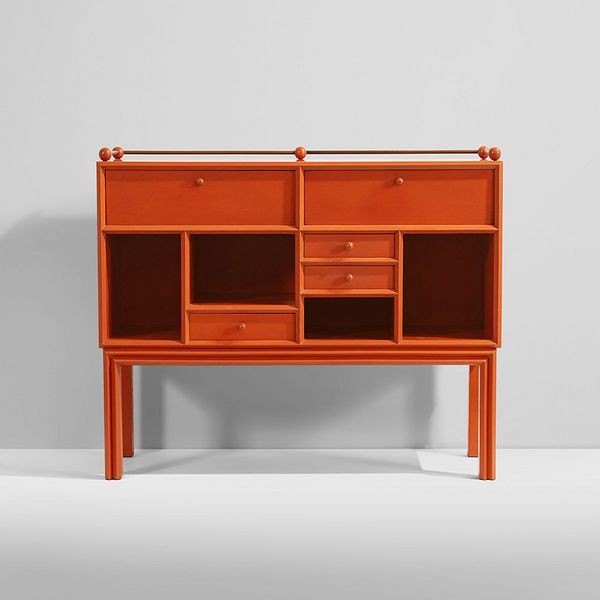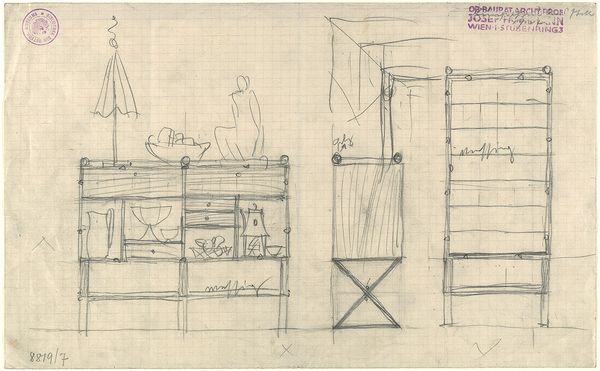Josef Hoffmann Unique sideboard, circa 1927 (Lot 86). Design London.
This magnificent work by Josef Hoffman features in our Design auction in London on 31 October.
By Dr. Christian Witt-Dörring
When he designed this cabinet in 1927, Hoffmann was at the peak of his creative career and international success despite simultaneously being exposed to Adolf Loos's intensified culturalcritical attacks. The years after the fall of the Austro-Hungarian monarchy were marked by contradictory conditions that were detrimental to the realization of Hoffmann's artistic ideas and projects. As artistic director of the Wiener Werkstätte, which was founded by him and from the outset was dependent on the patronage of the upper-middle classes for its luxury production, Hoffmann lost customers in the course of the economic decline of the young Austrian Republic, hyperinflation, and mass unemployment. In 1925, however, as director of the Austrian participation in the International Exhibition of Decorative Arts in Paris, he was able to realize the Austrian pavilion and set up a brilliant presentation of works by the Wiener Werkstätte. He was awarded the Order of the Legion of Honor by the French President for this project. At the same time, Loos was working on a residence for Tristan Zara in Paris and, in light of Hoffmann's pavilion and its programmatic focus on modern arts and crafts, he vehemently warned against its aberrations in relation to the needs of modern culture.
Preparatory drawing for the present work by Josef Hoffmann, circa 1926. Image: © MAK.
Loos made his criticism widely known. On 20 April 1927, he gave a lecture in the large hall of the Viennese Music Society entitled “The Viennese Woe... A Settlement of Accounts!” Only three weeks later, on 14 May, Hoffmann opened the 1927 Vienna Art Show at the Austrian Museum of Art and Industry, for which he designed the present cabinet. The exhibition consciously alluded to the tradition of the Viennese renewal of the arts of 1897 (founding of the Secession) and the 1908 Vienna Art Show (following the withdrawal of the Klimt group from the Secession in 1907). It was intended to serve as a motivation for a new generation of artists based on the experience of what had been achieved, particularly in these difficult times. In his opening speech, Hoffmann specifically addressed the social and economic realities of the Austrian interwar period and remarked: "You will perhaps see the poverty of our time at every turn in the crude nature of this exhibition, but in other respects you will not fail to notice that in this provisional presentation there is nevertheless a meaningful progress in the fact that continuous conscientious work teaches us to avoid any useless effort."
The cabinet is no longer part of a set or a Gesamtkunstwerk, thus unbound and adapted to the new living requirements of society. This unboundedness is heightened by the absence of any individual ornamentation. Nevertheless, it radiates individuality, which it owes purely to Hoffmann's design genius. At first glance, it is not any particular effort made towards material choice or craftsmanship that makes the furniture stand out. It is the simple colored varnish paint that defines the furniture as a clear volume. In typical Hoffmann manner, however, this volume allows for various interpretations. The question arises: is it the constructive three-dimensional reality of the furniture body that retains the visual upper hand or the way in which Hoffmann conceived the two dimensionality of the front. The latter is created by framing all structural design elements with triangular (in their cross-section) slats. In principle, this piece of furniture consists of a body and a stand. In the case of the stand, Hoffmann envisions a scenario—it involves laying the triangular slats, now in a double pack, only across its front—whereby the stand can no longer be read as an independent structural element. Ultimately, the furniture radiates symmetry. This symmetry, however, must first be worked out visually, as Hoffmann uses the disruptive element of the offset open and closed compartments. The result as a whole is that of an individualistic conception of harmony, consciously supported by a color scheme that was new for the time. Hoffmann’s opening speech ends with exactly that: ‘You will now think and already suspect that it is not only we who are aware of the special power of color. We have recognized that color as such has a quicker and stronger effect than anything else and that it has replaced much of what we will never be able to afford again, especially in interior design. Therefore, I will conclude with the words a sublime spirit once said. What would the world and our lives be without the color red?’
Discover More from Design, London >
Recommended Reading
Designing History: The furniture of Gabriella Colucci and Franco Pierluisi >
Signature Modern Treasures by Jean Royère >
Incisions into Space: Hans Coper's Cycladic Pots >
The Personal Pots: The Jane Coper and Cyril Frankel Collections >

